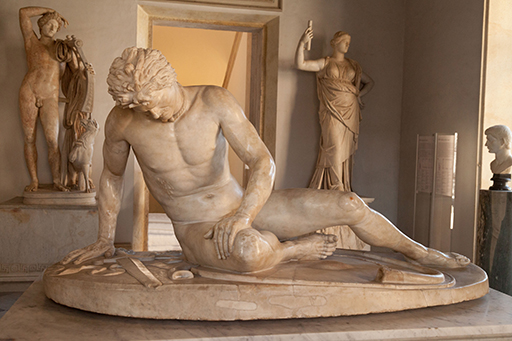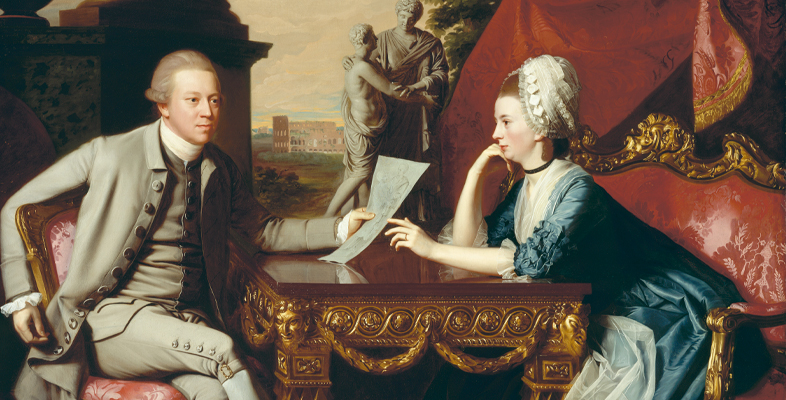Looking at Byron’s verse in more detail: paraphrase
Now you’re going to work on Byron’s poetry in more detail, by looking at a single stanza. Studying English Literature is all about being able to read accurately, and the skill of paraphrase is an essential basic. It’s a pretty useful skill generally, in fact. To paraphrase means to put the poem’s meanings into your own words – when it comes to paraphrasing poetry that means putting it into prose, glossing more unusual words, and often adding quite a lot of words to make explicit ideas that have been compressed grammatically.
Let’s look more closely at stanza 128 from the poem:
ARCHES on arches! as it were that Rome,
Collecting the chief trophies of her line,
Would build up all her triumphs in one dome,
Her Coliseum stands; the moonbeams shine
As ’twere its natural torches, for divine
Should be the light which streams here, to illume
This long-explored but still exhaustless mine
Of contemplation; and the azure gloom
Of an Italian night, where the deep skies assume…
Here is a first try at paraphrasing this first stanza from Reading 1 (Figure 13). It’s run on like prose and the added words are in red.
At more length, this is a worked-up prose version of the stanza and its run on into the next stanza:
Here arches are piled up on arches! As though the city of Rome, collecting up the memory of all her past military victories, had wanted to build all her triumphal arches into one circular building, the Coliseum. The moonlight which shines on it is the most appropriate sort of lighting for this place, both natural and heavenly, illuminating this long-famous and yet still fascinating-to-contemplate place. The dome of the deep blue Italian night-sky hangs above this vast and wonderful ruin and echoes its shape.
A reflection on that exercise would be something like this:
That was really hard to do! And I’m not sure I’ve got it right, either, or even quite understand it. What’s all that stuff about the skies assuming hues that have words, for instance? All the same, I found out something really interesting that I’d never noticed before – about how cleverly Byron had collapsed the idea of the Roman triumph with the triumphal arch and so made the Colosseum into the epitome of the Roman Empire. I also discovered how many ideas Byron had compressed into single words, e.g. ‘natural’ and ‘mine’. And I also discovered that his verse is way better than my prose.
Activity 8
Now that you’ve spent a bit of time reading this part of the poem more carefully, how would you sum up Byron’s thoughts on the Colosseum and the ways in which it epitomises the ancient city of Rome. How does he characterise ancient Roman imperial culture? Does he admire it? What can the modern tourist do with and within the surviving ruins? What sort of encounter is this?
Discussion
Byron’s vision of Rome is epitomised by this miniature essay on the Colosseum. He sets up a little drama here: the ancient ruins are first of all viewed as, like all ruins, ‘Romantic’, in that they speak of the past (stanzas 128–9); then, from stanza 139, Byron experiments with revivifying them through his imagination as the epicentre of imperial power; then he focuses this story of imperial power through the memories and affections of the dying gladiator (‘I see before me the Gladiator lie’, stanza 140; here Byron is bringing the famous statue (Figure 14) to life); and then returns, via the idea of the revengeful Goths who would indeed eventually overrun Rome, to the Colosseum as a ruin, best viewed by moonlight which softens dilapidation.

The passage as a whole is a meditation upon the bloodiness of empires, and of their ends, strung between attraction to ancient heroism and cynical disillusion at modernity, in which the heroic dwindles into a world of ‘thieves, or what ye will.’ Most importantly, though, this passage also dramatises the power and movement of Byron’s imagination – it all happens in his head with a little aid from moonlight. And it also casts Byron as an especially glamorous tourist – like the dying gladiator, these stanzas suggest, he is an exile, far from home, defeated by the inevitability of death, but his emotions are the centre of attention all the same. A tourist to Rome might well feel trite or belated – but not if he or she could channel Byron. For this reason, Murray’s guidebook excerpted this passage in its entirety, allowing tourists to play at being Byron on the spot, preferably by moonlight.

![This image shows a paraphrase of the first stanza of Byron’s poem with the following words added in red: ‘Here are’; ‘piled’; ‘top of’; ‘i.e. history’; ‘i.e. triumphal arches’; ‘Here’; ‘[Rome’s]’; ‘though they’; ‘appropriate’; ‘[illuminate]’; ‘[unexhausted]’.](https://www.open.edu/openlearn/pluginfile.php/3352326/mod_oucontent/oucontent/110537/efe094d8/d0cf0286/a112_vle_bk1_u4_wk05_fig019.eps.jpg)